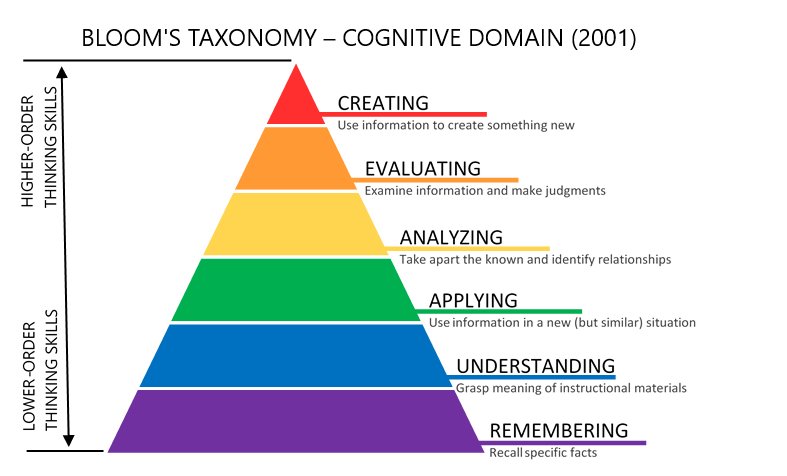Bloom's taxonomy
Introduction to Bloom's taxonomy
Bloom's Taxonomy, initially introduced by Benjamin Bloom in 1956, has been widely adopted as a framework for categorizingcategorising educational goals. Revised to promote more dynamic learning objectives, it outlines a range of cognitive skills from basic recall to complex analytical and creative tasks. This guide provides learning designers with an understanding of the taxonomy's structure and practical applications for course design.
Levels of cognitive skills
Bloom's Taxonomy organizesorganises learning objectives into six hierarchical levels, each requiring a deeper cognitive engagement:
-
Remembering: Retrieving knowledge from long-term memory.
- Verbs: List, Describe, Name, Identify
- Application: Learners could be asked to list the main events of a historical battle.
-
Understanding: Constructing meaning from instructional messages.
- Verbs: Explain,
Summarize,Summarise, Paraphrase, Classify - Application: Learners might
summarizesummarise the key points of a research article.
- Verbs: Explain,
-
Applying: Using procedures in a given situation.
- Verbs: Use, Implement, Execute
- Application: Learners could use a mathematical formula to solve a real-world problem.
-
AnalyzingAnalysing: Breaking material into parts to understand its structure.- Verbs:
Analyze,Analyse, Differentiate, Compare - Application: Learners might compare two philosophical theories to evaluate their effectiveness.
- Verbs:
-
Evaluating: Making judgments based on criteria and standards.
- Verbs: Evaluate, Critique, Judge
- Application: Learners could critique a piece of artwork based on established criteria.
-
Creating: Putting elements together to form a coherent or functional whole.
- Verbs: Create, Design, Construct
- Application: Learners might design a marketing strategy for a new product.
 https://citt.ufl.edu/resources/the-learning-process/designing-the-learning-experience/blooms-taxonomy/blooms-taxonomy-graphic-description/
https://citt.ufl.edu/resources/the-learning-process/designing-the-learning-experience/blooms-taxonomy/blooms-taxonomy-graphic-description/
Implementing Bloom's taxonomy in course design
integrating Bloom's Taxonomy into course design and course mapping helps create a structured and effective learning environment that systematically enhances cognitive engagement and ensures that all course components – objectives, content, assessments, and instructional methods – are cohesively aligned to support student learning and achievement
When designing a course map, consider the following steps to effectively incorporate Bloom's Taxonomy:
- Align Objectives with Educational Goals: Ensure that learning objectives at each level of the taxonomy align with the overall educational goals of the course.
- Progressive Complexity: Design course content to progressively challenge learners, starting from basic recall tasks to more complex analysis and creation tasks.
- Assessment Strategies: Develop assessments that appropriately evaluate learning at each taxonomy level. Remembering and understanding might be assessed through multiple-choice
questions,questions while creating and evaluating might require essays or projects. - Instructional Methods: Choose teaching methods that foster the desired level of cognitive engagement. Interactive discussions, problem-solving sessions, and group projects are effective for higher levels of cognition.
Benefits of using Bloom's taxonomy
- Enhanced Course Structure: Provides a clear roadmap for course development, ensuring a balanced approach to teaching and learning.
- Improved Learning Outcomes: Encourages diverse cognitive activities, helping learners develop higher-order thinking skills.
- Clearer Assessment Criteria: Facilitates the creation of assessment rubrics that align with learning objectives, ensuring more precise evaluation of student performance.
